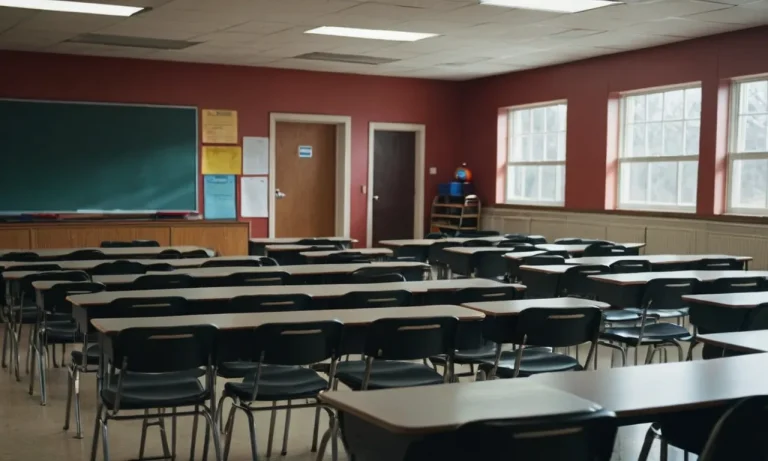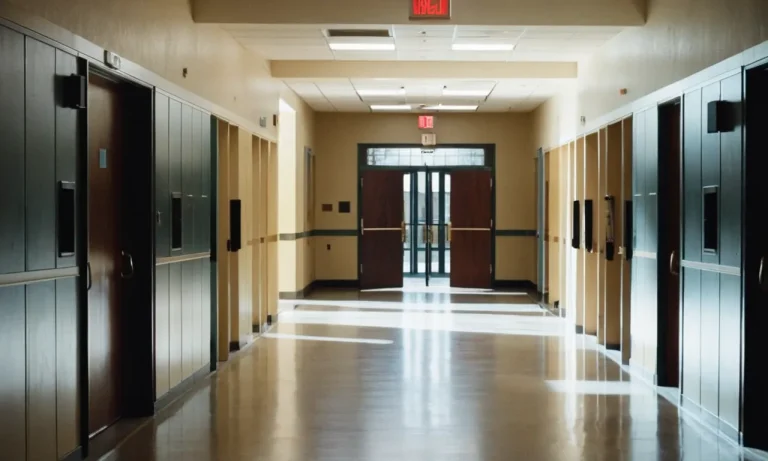When it comes to minor injuries or ailments at school, the go-to remedy often seems to be a simple ice pack. Have you ever wondered why school nurses seem to rely so heavily on this chilly treatment? The answer lies in a combination of practical considerations, legal constraints, and a commitment to student safety.
If you’re short on time, here’s a quick answer to your question: School nurses primarily give ice because it’s a safe, cost-effective, and legally permissible way to provide immediate relief for minor injuries and discomforts without administering medication or engaging in more invasive treatments.
In this comprehensive article, we’ll delve into the reasons behind this common practice, exploring the benefits of ice therapy, the legal and ethical considerations involved, and the role of school nurses in promoting student well-being.
We’ll also discuss alternative treatments and when it’s appropriate to seek further medical attention.
The Benefits of Ice Therapy
When it comes to treating minor injuries or discomfort, school nurses often turn to the trusty ice pack as their go-to remedy. But why is ice therapy so widely recommended? The answer lies in its remarkable ability to provide relief and promote healing through a range of beneficial effects.
Let’s dive into the details!
Reducing Inflammation and Pain
One of the primary benefits of ice therapy is its power to reduce inflammation and alleviate pain. When you sustain an injury, your body’s natural response is to release inflammatory chemicals, which can cause swelling, redness, and discomfort.
By applying cold therapy, you can constrict blood vessels and slow down this inflammatory process, effectively minimizing pain and discomfort. According to a study published in the Journal of Athletic Training, ice application can significantly reduce pain levels within the first 48 hours of an acute injury.
Minimizing Swelling
Swelling is another common symptom that often accompanies injuries, and ice therapy can be a game-changer in managing this issue. When you apply cold to an injured area, it causes the blood vessels to constrict, reducing the flow of fluid and minimizing swelling.
This can be particularly beneficial for injuries like sprains or contusions, where swelling can exacerbate pain and limit mobility. 🥶 A study published in the Journal of Orthopaedic & Sports Physical Therapy found that applying ice for 20 minutes can significantly reduce swelling in acute ankle sprains.
Promoting Healing
While ice therapy is often associated with immediate relief, it can also play a crucial role in the healing process. By reducing inflammation and swelling, ice application creates an environment that is more conducive to healing.
Additionally, cold therapy can help minimize tissue damage and promote the recovery of injured muscles, tendons, and ligaments. According to a review published in the Journal of Sports Medicine and Physical Fitness, early application of cryotherapy (cold therapy) can significantly improve functional outcomes and accelerate the healing process after musculoskeletal injuries.
So, the next time you visit the school nurse with a minor injury or discomfort, don’t be surprised if they hand you an ice pack. 😊 It’s a simple yet effective remedy that can provide relief, minimize swelling, and even promote healing.
Just remember to follow the nurse’s instructions and apply the ice pack for the recommended duration and frequency. With the power of ice therapy on your side, you’ll be on the road to recovery in no time!
Legal and Ethical Considerations
When it comes to school nurses administering medication, there are several legal and ethical considerations that must be taken into account. These considerations are in place to ensure the safety and well-being of students, while also protecting the school and its staff from potential liabilities.
Medication Administration Policies
Most schools have strict policies in place regarding the administration of medication to students. These policies typically require parental consent, a doctor’s prescription, and specific guidelines for storing and dispensing medication.
According to the National Association of School Nurses (https://www.nasn.org/), over 25 million students in the United States require medication during the school day. As such, it is crucial for school nurses to adhere to these policies to ensure the proper handling and distribution of medication.
Liability Concerns
School nurses must exercise caution when administering medication to students, as they can be held liable for any adverse reactions or complications that may arise. This is why many nurses opt to provide ice instead of medication, as it is a safe and non-invasive treatment option.
According to a study by the American Academy of Pediatrics (https://www.aap.org/), approximately 10% of medication errors in schools result in adverse events. To mitigate these risks, school nurses undergo extensive training and are required to maintain accurate records of all medication administered.
Maintaining Professional Boundaries
Another important consideration for school nurses is maintaining professional boundaries with students and their families. While it is natural to develop a rapport with students, it is essential for nurses to maintain a level of detachment to avoid potential conflicts of interest or ethical dilemmas.
This can be particularly challenging in situations where parents or students may pressure the nurse to administer medication or provide treatment beyond their scope of practice. In such cases, nurses must remain firm in their adherence to policies and ethical guidelines, even if it means disappointing or upsetting the student or family member.
By navigating these legal and ethical considerations with care and diligence, school nurses can ensure that they are providing the best possible care to their students while also protecting themselves and their institutions from potential liabilities.
After all, the health and safety of students should always be the top priority. 😊
The Role of School Nurses
School nurses play a vital role in promoting the health and well-being of students, ensuring they are able to learn and thrive in a safe environment. Their responsibilities go far beyond simply handing out ice packs (although that’s certainly part of it! 😉).
Let’s dive into the multifaceted duties of these dedicated healthcare professionals.
Triage and First Aid
One of the primary responsibilities of school nurses is to provide triage and first aid services. They assess and treat minor injuries and illnesses, such as cuts, scrapes, headaches, and stomachaches.
When a student arrives at the nurse’s office, the nurse must quickly evaluate the situation and determine the appropriate course of action. This may involve administering first aid, contacting parents or emergency services, or referring the student to a healthcare provider for further evaluation.
According to the National Association of School Nurses, school nurses handle an average of 58 health office visits per day, highlighting the importance of their triage and first aid skills.
Health Education and Promotion
School nurses play a crucial role in promoting healthy behaviors and educating students, staff, and families on various health-related topics. They develop and implement health education programs, covering subjects such as nutrition, physical activity, substance abuse prevention, and disease prevention.
By fostering a culture of health and wellness within the school community, nurses can empower students to make informed decisions and adopt healthy habits that will benefit them throughout their lives.
In fact, research has shown that schools with comprehensive health education programs have higher academic achievement and reduced absenteeism rates.
Collaboration with Parents and Healthcare Providers
Effective communication and collaboration are essential for school nurses to ensure the well-being of students. They work closely with parents or guardians to manage chronic conditions, discuss health concerns, and provide guidance on health-related matters.
Additionally, school nurses collaborate with healthcare providers, such as physicians, specialists, and mental health professionals, to ensure continuity of care and coordinate services for students with special health needs.
This collaborative approach creates a support system that addresses the unique needs of each student, fostering a positive and inclusive learning environment.
When to Seek Further Medical Attention
While school nurses are trained to handle minor injuries and illnesses, there are times when further medical attention is necessary. Don’t underestimate the expertise of these healthcare professionals, but also be aware that they have limitations in their scope of practice.
Here are some situations where you should consider seeking additional medical care:
Severe or Persistent Symptoms
If a student exhibits severe symptoms such as intense pain, high fever, severe bleeding, or difficulty breathing, it’s crucial to seek emergency medical attention immediately. Similarly, if symptoms persist or worsen despite the nurse’s initial treatment, it may be a sign of an underlying condition that requires further evaluation.
According to a study by the Centers for Disease Control and Prevention (CDC), approximately 20% of school nurse visits involve injuries or illnesses that require referral to a healthcare provider.
Head Injuries
Head injuries, even seemingly minor ones, should be taken seriously. While a school nurse can provide initial care, any suspected concussion or traumatic brain injury requires prompt evaluation by a medical professional.
The CDC’s HEADS UP program provides valuable information on recognizing and responding to head injuries in school settings. 😊 Don’t hesitate to seek further medical attention if a student experiences symptoms such as persistent headache, dizziness, or confusion after a head injury.
Allergic Reactions
Allergic reactions can range from mild to life-threatening, and school nurses are trained to respond accordingly. However, severe allergic reactions (anaphylaxis) require immediate emergency medical attention.
If a student experiences difficulty breathing, swelling of the face or throat, or a sudden drop in blood pressure after exposure to an allergen, call emergency services immediately. According to Food Allergy Research & Education (FARE), approximately 1 in 13 children in the United States has a food allergy, highlighting the importance of prompt response to allergic reactions in school settings.
Remember, school nurses are dedicated professionals who aim to provide the best possible care for students. However, they are not a substitute for specialized medical attention when severe or persistent symptoms arise.
By being aware of when to seek further medical care, you can ensure that students receive the appropriate level of treatment and support for their health and well-being. 👏
Conclusion
While the practice of school nurses primarily giving ice may seem simplistic, it’s a well-reasoned approach rooted in practical, legal, and ethical considerations. Ice therapy offers a safe and effective way to provide immediate relief for minor injuries and discomforts without the need for medication or invasive treatments.
However, it’s important to recognize that ice is not a cure-all solution, and there are situations where further medical attention is necessary. School nurses play a crucial role in triaging students, providing first aid, and collaborating with parents and healthcare providers to ensure the well-being of every child under their care.
By understanding the rationale behind this common practice and the broader responsibilities of school nurses, we can better appreciate the vital role they play in promoting student health and safety within the educational environment.






